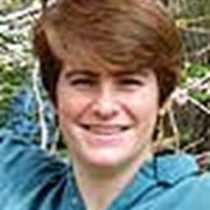Minks, medusae, and more!
Time and tide wait for no person. Knowing that, we boarded our inflatables well before breakfast to cruise the low tide at the Bay of Pillars. The early morning light was magical on the jade water. Pulsing dinner plate-sized yellow jellies and pumping thimble-sized white hydromedusae wafted along on the turbulent tidal current. Sea otters floated, rolled and dove among the flowing blades of bull kelp, and small harbor seals with their old-man-eyebrows and whiskers assessed us across the glassy fetch. Multiple mink bounded over boulders in the low intertidal, curiously peering before ducking behind a sprig of Fucus rockweed. But the most amazing bounty was on the craggy, moist rock walls lining the channel. Below the water, fields of white tentacles bloomed as anemones packed every available nook and cranny. Out of the water, these sizable cnidarians became pendulous, covering the rocks with white and orange stalks that mimicked cold molasses just about to drop off a tilted spoon. Reaching out, we plucked off many species of sea stars: bright orange blood stars, the multi-armed sunflower star, and the Solaster with its orange background and blue stripes radiating down each arm. Close relatives of the sea stars were also within reach: floppy sea cucumbers that stiffened in our hands, their tube feet waving to find more solid purchase. The rocks themselves were almost white with barnacles and their predators, a drilling snail. The whirlpools of this area belied the powerful forces flowing through these channels, and the particles flying by in the depths convinced us of the rich plethora of food that supports all of the suspension feeding invertebrates we were investigating. In turn, these spineless wonders feed the charismatic megafauna.
We struck off on an exploratory hike through a stream meadow. Fording the stream, we squatted to observe mayflies and sculpin eggs clinging to the underside of rocks. Lining the sides of this stream, shooting stars, paintbrush and buttercups were blooming in profusion. Entering the forest, the microclimate changed drastically as the temperature dropped, the incident radiation plummeted, and our feet sank into mossy tussocks. Wandering along bear trails we saw jawbones with the impressive canines of a salmon in its mating morphology, evidence that we were not the first vertebrates to enter this primeval forest.
For the afternoon, we cruised and viewed the immense sheer rock faces of Red Bluff Bay. The afternoon was hot, too hot for most bears. We watched one coastal brown bear stroll along the beach and into the cooler woods. We ourselves needed a cool-down, so we cruised right up to a plunging waterfall, almost misting those on the bow!
Time and tide wait for no person. Knowing that, we boarded our inflatables well before breakfast to cruise the low tide at the Bay of Pillars. The early morning light was magical on the jade water. Pulsing dinner plate-sized yellow jellies and pumping thimble-sized white hydromedusae wafted along on the turbulent tidal current. Sea otters floated, rolled and dove among the flowing blades of bull kelp, and small harbor seals with their old-man-eyebrows and whiskers assessed us across the glassy fetch. Multiple mink bounded over boulders in the low intertidal, curiously peering before ducking behind a sprig of Fucus rockweed. But the most amazing bounty was on the craggy, moist rock walls lining the channel. Below the water, fields of white tentacles bloomed as anemones packed every available nook and cranny. Out of the water, these sizable cnidarians became pendulous, covering the rocks with white and orange stalks that mimicked cold molasses just about to drop off a tilted spoon. Reaching out, we plucked off many species of sea stars: bright orange blood stars, the multi-armed sunflower star, and the Solaster with its orange background and blue stripes radiating down each arm. Close relatives of the sea stars were also within reach: floppy sea cucumbers that stiffened in our hands, their tube feet waving to find more solid purchase. The rocks themselves were almost white with barnacles and their predators, a drilling snail. The whirlpools of this area belied the powerful forces flowing through these channels, and the particles flying by in the depths convinced us of the rich plethora of food that supports all of the suspension feeding invertebrates we were investigating. In turn, these spineless wonders feed the charismatic megafauna.
We struck off on an exploratory hike through a stream meadow. Fording the stream, we squatted to observe mayflies and sculpin eggs clinging to the underside of rocks. Lining the sides of this stream, shooting stars, paintbrush and buttercups were blooming in profusion. Entering the forest, the microclimate changed drastically as the temperature dropped, the incident radiation plummeted, and our feet sank into mossy tussocks. Wandering along bear trails we saw jawbones with the impressive canines of a salmon in its mating morphology, evidence that we were not the first vertebrates to enter this primeval forest.
For the afternoon, we cruised and viewed the immense sheer rock faces of Red Bluff Bay. The afternoon was hot, too hot for most bears. We watched one coastal brown bear stroll along the beach and into the cooler woods. We ourselves needed a cool-down, so we cruised right up to a plunging waterfall, almost misting those on the bow!




